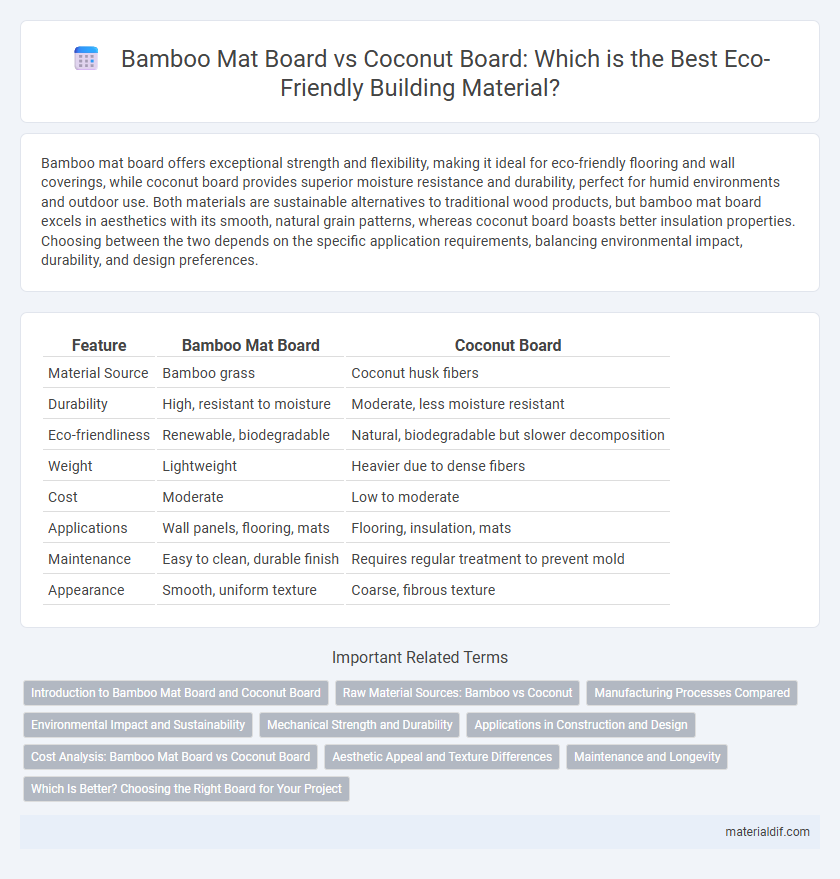Bamboo mat board offers exceptional strength and flexibility, making it ideal for eco-friendly flooring and wall coverings, while coconut board provides superior moisture resistance and durability, perfect for humid environments and outdoor use. Both materials are sustainable alternatives to traditional wood products, but bamboo mat board excels in aesthetics with its smooth, natural grain patterns, whereas coconut board boasts better insulation properties. Choosing between the two depends on the specific application requirements, balancing environmental impact, durability, and design preferences.
Table of Comparison
| Feature | Bamboo Mat Board | Coconut Board |
|---|---|---|
| Material Source | Bamboo grass | Coconut husk fibers |
| Durability | High, resistant to moisture | Moderate, less moisture resistant |
| Eco-friendliness | Renewable, biodegradable | Natural, biodegradable but slower decomposition |
| Weight | Lightweight | Heavier due to dense fibers |
| Cost | Moderate | Low to moderate |
| Applications | Wall panels, flooring, mats | Flooring, insulation, mats |
| Maintenance | Easy to clean, durable finish | Requires regular treatment to prevent mold |
| Appearance | Smooth, uniform texture | Coarse, fibrous texture |
Introduction to Bamboo Mat Board and Coconut Board
Bamboo mat board is a sustainable, eco-friendly material crafted from woven bamboo fibers, offering durability and a natural aesthetic ideal for packaging and construction. Coconut board, derived from compressed coconut coir and husk fibers, provides excellent insulation properties and moisture resistance suited for eco-conscious applications. Both materials emphasize renewable resources, but bamboo mat board excels in tensile strength while coconut board is favored for its lightweight, cushioning qualities.
Raw Material Sources: Bamboo vs Coconut
Bamboo mat boards derive from fast-growing bamboo stalks, known for their sustainability and rapid renewability, making them an eco-friendly choice. Coconut boards are made from coir fibers extracted from the outer husk of coconuts, utilizing agricultural waste and promoting waste reduction. Both raw material sources offer biodegradable and renewable options, but bamboo's rapid growth rate provides a more abundant and consistent supply than coconut husks.
Manufacturing Processes Compared
Bamboo mat board manufacturing involves harvesting bamboo stalks, boiling, and pressing fibers into sheets using adhesives, resulting in a sturdy, flexible product. Coconut board production utilizes coconut coir fibers bonded with resin under heat and pressure, creating a dense, moisture-resistant board. The bamboo process emphasizes rapid renewable resource utilization and energy-efficient pressing, while coconut board manufacturing prioritizes fiber extraction from husks and resin curing for durability.
Environmental Impact and Sustainability
Bamboo mat boards offer superior sustainability due to bamboo's rapid growth rate and ability to sequester carbon efficiently, making it a renewable resource with a low environmental footprint. In contrast, coconut boards, while also biodegradable and made from agricultural waste, rely on slower-growing coconut palms and often involve more intensive processing, which can increase their ecological impact. Choosing bamboo mat boards supports reduced deforestation and promotes sustainable forestry practices compared to coconut-based alternatives.
Mechanical Strength and Durability
Bamboo mat boards exhibit superior mechanical strength compared to coconut boards, attributed to their dense fiber structure and natural flexibility, making them ideal for heavy-duty applications. Bamboo's durability is enhanced by its resistance to moisture and pests, ensuring a longer lifespan under varying environmental conditions. In contrast, coconut boards tend to be less robust and more susceptible to wear and degradation over time.
Applications in Construction and Design
Bamboo mat board offers superior flexibility and tensile strength, making it ideal for lightweight partition walls, decorative panels, and eco-friendly flooring in sustainable construction projects. Coconut board, derived from coconut coir fibers, excels in insulation and moisture resistance, making it suitable for acoustic panels, soundproofing, and humidity-prone environments. Both boards provide renewable alternatives, with bamboo favored for structural elements and coconut board preferred for insulation and design applications.
Cost Analysis: Bamboo Mat Board vs Coconut Board
Bamboo mat board typically offers a more cost-effective option compared to coconut board due to its faster growth rate and lower processing expenses, making it suitable for large-scale production at reduced prices. Coconut board, derived from coconut fiber, involves higher raw material and manufacturing costs, resulting in a pricier end product with enhanced durability and moisture resistance. When evaluating long-term investment, bamboo mat board provides affordability, whereas coconut board may justify higher costs through increased lifespan and performance.
Aesthetic Appeal and Texture Differences
Bamboo mat board offers a sleek, smooth surface with a natural fine grain that enhances minimalistic and modern interior designs. In contrast, coconut board exhibits a coarser texture with irregular, fibrous patterns that provide a rustic and organic aesthetic. The distinct tactile qualities of bamboo mat board deliver a polished look, while coconut board emphasizes a more textured, eco-friendly appearance.
Maintenance and Longevity
Bamboo mat boards offer superior durability and require minimal maintenance due to their natural resistance to moisture and pests, making them ideal for long-term use in humid environments. Coconut boards, while eco-friendly and biodegradable, tend to absorb moisture easily and may degrade faster without regular upkeep. Proper cleaning and occasional sealing extend the lifespan of both materials, but bamboo's inherent strength generally ensures greater longevity compared to coconut-based alternatives.
Which Is Better? Choosing the Right Board for Your Project
Bamboo mat board offers superior durability and sustainability due to its rapid growth and strong fibers, making it ideal for eco-friendly projects requiring strength and flexibility. Coconut board, derived from coconut husk fibers, provides excellent moisture resistance and natural texture, perfect for decorative or humid environment applications. Choosing the right board depends on project needs for durability, moisture resistance, and environmental impact, with bamboo favored for structural uses and coconut suited for aesthetic or moisture-prone conditions.
Bamboo mat board vs Coconut board Infographic

 materialdif.com
materialdif.com